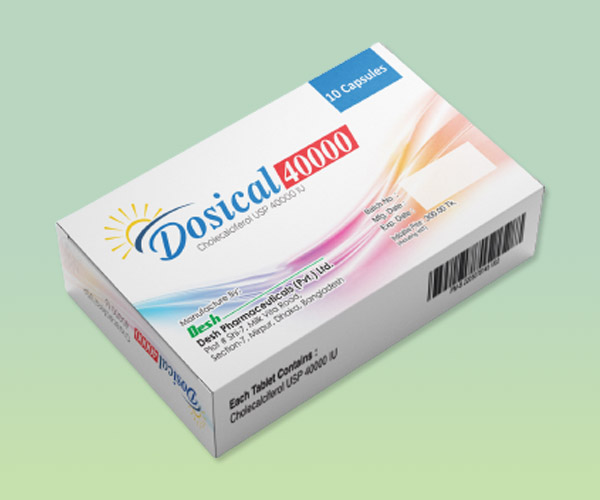Dosical 40000
Cholecalciferol USP 40000 IU
Dosical 40000
Cholecalciferol USP 40000 IU
composition
Dosical 40000 IU Capsule: Each capsule contains Vitamin D3 40000 IU as Cholecalciferol USP.
Description
Vitamin D is a group of fat-soluble secosteroids responsible for increasing intestinal absorption of calcium, magnesium, and phosphate, and multiple other biological effects. In humans, the most important compounds in this group are vitamin D3 (also known as cholecalciferol) and vitamin D2 (ergocalciferol).
- AVAILABILITY: AVAILABLE
omposition
Dosical 40000 IU Capsule: Each capsule contains Vitamin D3 40000 IU as Cholecalciferol USP.
Description
Vitamin D is a group of fat-soluble secosteroids responsible for increasing intestinal absorption of calcium, magnesium, and phosphate, and multiple other biological effects. In humans, the most important compounds in this group are vitamin D3 (also known as cholecalciferol) and vitamin D2 (ergocalciferol).
Pharmacology
The active form of Vitamin D3, Calcitriol, exerts its effect by binding to the vitamin D3 receptors (VDRs) which are widely distributed through many body tissues. Vitamin D3 has a half-life of approximately 50 days as it is fat-soluble. Vitamin D3 is absorbed in the small intestine and bound to specific globulins and transported to the liver where it is metabolized to 25-hydroxy Vitamin D3 (Calcitriol) occurs in the kidney. The metabolite is responsible for the vitamin’s ability to increase the absorption of calcium. Non-metabolized Vitamin D3 is stored in tissues such as fat and muscles. Vitamin D3 is eliminated via faeces and urine.
Indication
VitaminD3 deficiency can occur in people whose exposure to sunlight is limited and in those whose diet is deficient in Vitamin D3. Vitamin D3 is essential for the effective calcium and phosphate absorption required for healthy bones and teeth, preventing rickets, osteomalacia and osteoporosis. High doses are also very effective in institutionalized or hospitalized patients. Vitamin D3 is important during pregnancy and breastfeeding as it is an essential nutrient for a growing infant.
Dosage and administration
Tablet:
1000 IU (1-2 tablets) daily, or as directed by a physician. Take the medicine with food or within 1 hour after a meal.
2000 IU (1 tablet) daily, as directed by a physician. Take the medicine with food or within 1 hour after a meal.
Capsule:
Adults:
Treatment of cholecalciferol deficiency: 40000 IU once every week for 7 weeks followed by 40000 IU each a month for 3 to 4 months.
Follow-up measurements should be made approximately 3 to 4 months after initiating maintenance therapy to confirm that the target level has been achieved.
Prevention of cholecalciferol deficiency: 20000 IU every 4 weeks (1 capsule), a higher dose may be required in certain populations.
Children
Treatment of cholecalciferol deficiency (12-18 years): 20000 IU (1 capsule) once every 2 weeks for 6 weeks.
Prevention of cholecalciferol deficiency (12-18 years): 20000 IU (1 capsule) every 6 weeks.
Contraindication
• Hypersensitivity to the active substance(s) or to any of the excipients listed in section 6.1
• Hypervitaminosis D
• Nephrolithiasis
• Nephrocalcinosis
• Diseases or conditions resulting in hypercalcemia and/or hypercalciuria (e.g. myeloma, bone metastases or other malignant bone disease, primary hyperparathyroidism)
• Severe renal impairment
Side effects
Flatulence, diarrhoea, constipation, upper GI discomfort, allergic reactions etc are rare manifestations. Hypercalcemia due to prolong use has rarely been reported.
Precaution
In mild hypercalciuria, careful monitoring with a reduction of the dose is sufficient to return to normal serum calcium concentration. Plasma and serum calcium levels should be monitored in mild to moderate renal impairment and also in case of long-term use. Patients with renal stones or with such previous history should be recommended to increase their fluid intake.
Drug interaction
Concomitant use of phenytoin or barbiturates may reduce the effect of vitamin D due to an increase in the rate of its metabolism.
Simultaneous treatment with ion exchange resins such as cholestyramine or laxatives such as paraffin oil may reduce the gastrointestinal absorption of vitamin D.
Concomitant use of glucocorticoids can decrease the effect of vitamin D.
Increased levels of vitamin D can induce hypercalcemia, which may increase the risk of digitalis toxicity and serious arrhythmias due to the additive inotropic effects. The electrocardiogram (ECG) and serum calcium levels of patients should be closely monitored.
Thiazide diuretics reduce the urinary excretion of calcium. Due to the increased risk of hypercalcemia, serum calcium should be regularly monitored during the concomitant use of thiazide diuretics.
Overdosage
The most serious consequence of acute or chronic overdose is hypercalcemia due to vitamin D toxicity. Symptoms may include nausea, vomiting, polyuria, anorexia, weakness, apathy, thirst and constipation, somnolence and vertigo. Chronic overdoses can lead to vascular and organ calcification as a result of hypercalcemia. Treatment should consist of stopping all intake of vitamin D and rehydration.
Use in pregnancy, lactation and fertility
Pregnancy
There is no or limited amount of data on the use of cholecalciferol in pregnant women. Studies in animals have shown reproductive toxicity (see section 5.3). The recommended daily intake for pregnant women is up to 600 IU. However, in women who are considered to be vitamin D deficient, a higher dose may be required. During pregnancy, women should follow the advice of their medical practitioner as their requirements may vary depending on the severity of their deficiency and their response to treatment. There are no indications that vitamin D at therapeutic doses is teratogenic in humans.
Breast-feeding
Vitamin D and its metabolites are excreted in breast milk. Overdose in infants induced by nursing mothers has not been observed; however, when prescribing additional vitamin D to a breast-fed child the practitioner should consider the dose of any additional vitamin D given to the mother.
Fertility
There are no data on the effect of Stexerol-D3 on fertility. However, normal endogenous levels of vitamin D are not expected to have any adverse effects on fertility.
Storage
Store in a cool, dry place between 300C temperature and protect from light. Keep out of reach of children.
Packing
Dosical 40000 IU Capsule: Box containing 1×10 / 2×10 capsules in a blister pack.
